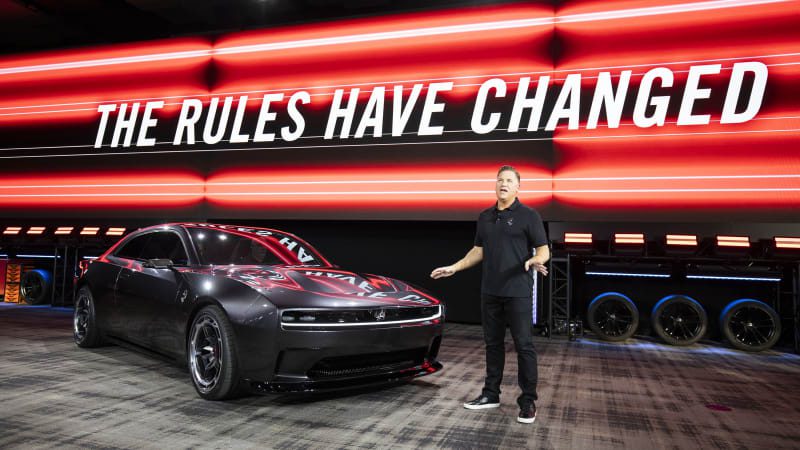CEO Tim Kuniskis' retirement is the latest big change at Dodge and Ram

Tim Kuniskis reveals the Dodge Charger Daytona SRT Concept all-electric muscle car in 2022. (Getty Images)
DETROIT — Though Tim Kuniskis, CEO of the Ram and Dodge brands and the unofficial voice of American muscle cars, is retiring after nearly 32 years with Stellantis, that’s not the only big change the brands are going through, particularly Dodge. And an analyst says “It wouldn’t be wise to presume no one else can champion the brand.”
The announcement Friday comes as Stellantis struggles with U.S. sales as it begins the transition from internal combustion to electric vehicles. Through April, its sales were down 14.1% while the industry as a whole saw a 3.1% increase, according to Motorintelligence.com.
For years Kuniskis was the spokesman for high-performance American cars, introducing many powerful models including last year’s 1,025 horsepower Challenger SRT Demon 170. But in March, Kuniskis led the unveiling of two battery-powered versions of the Charger muscle car, while keeping one gas-powered version of the Charger without a big Hemi V8.
Kuniskis was CEO of both the Dodge and Ram brands. He’ll be replaced at Ram by Chris Feuell, who will take on Ram in addition to her duties leading the Chrysler brand. Matt McAlear will become Dodge brand CEO. He led Dodge sales and has broad automotive experience, the company said in a statement.
Both brands are struggling with Dodge phasing out the old versions of the gas powered Charger and Challenger as it moves to electric vehicles. Dodge sales through April are down more than 17%. The brand also is selling the Hornet small SUV made in Italy, but it hasn’t caught on.
Ram sales are down over 29% so far this year as a Michigan factory is retooled to build an updated full-size pickup.
Kuniskis’ passion and vision for the Dodge brand will be a loss, but someone else at Stellantis may be able to take over, said S&P Global analyst Stephanie Brinley.
“Dodge muscle car future is going through change, regardless of who is at the helm,” Brinley said in an email. “Success will still come to product execution and whether the vision for the Dodge brand aligns with how customers see the brand. It wouldn’t be wise to presume no one else can champion the brand.”
At a March event in Detroit showing off the new electric Chargers, Kuniskis also exhibited a gas-fueled Charger powered by a new 3-liter six-cylinder engine with two turbochargers. A high-output version will have 550 horsepower. Kuniskis defended keeping the gasoline version and said the electric muscle cars, which will roar like gas-engine vehicles, will emphasize performance over efficiency.
Under normal circumstance, he said, about 17 million vehicles are sold annually in the U.S., so there’s room for both versions “You know what? People need choices,” he said.
Kuniskis said he would expect criticism from environmental groups if Dodge had not come out with electric versions of the Charger. “It’s designed for performance and it has low range, but it’s still a battery electric vehicle. They’re going to hate on that? Seems kind of odd,” he said.
Globally, Stellantis’ first quarter global vehicle shipments fell 10% from a year ago to 1.34 million, and revenue dropped 12% to 41.7 billion euros ($44.8 billion).
The company blamed the revenue dip on lower sales as it manages production and inventory while launching 25 new models this year, including 18 electric vehicles. Chief Financial Officer Natalie Knight said Stellantis believes the new models will bring “materially improved growth and profitability in the second half.”



